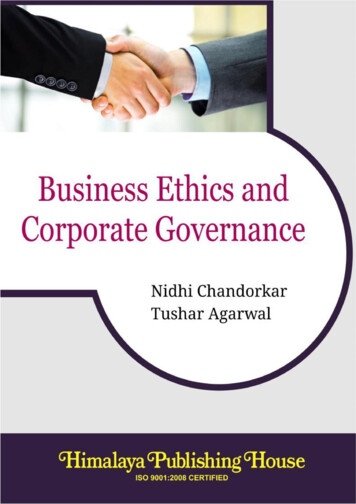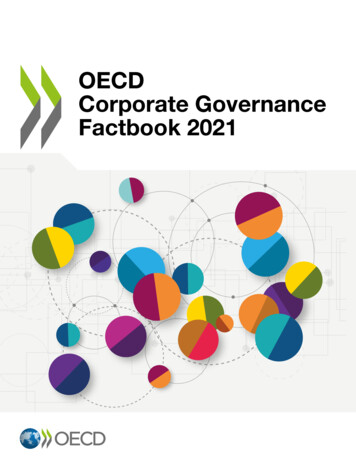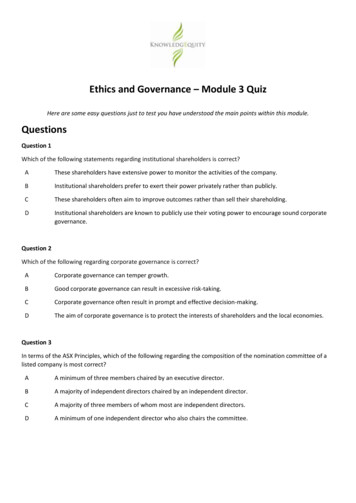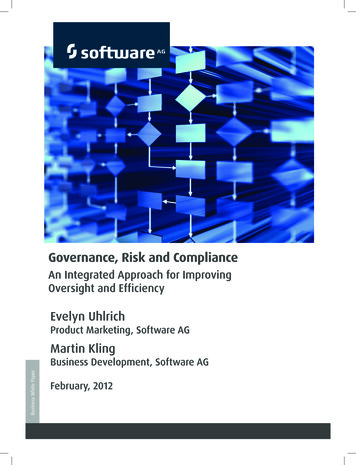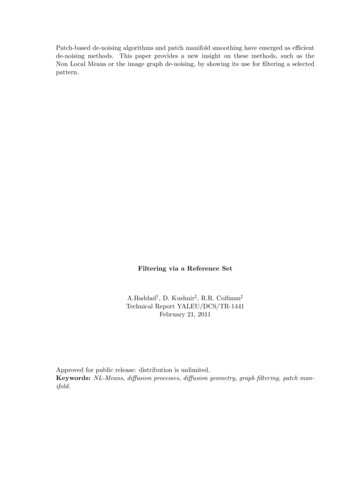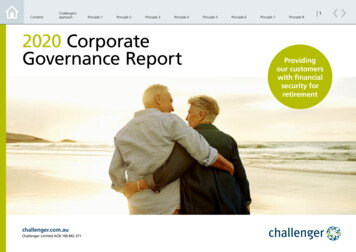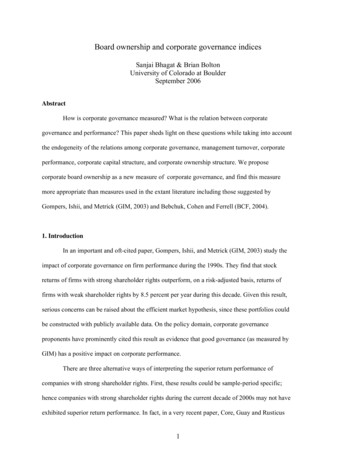
Transcription
Board ownership and corporate governance indicesSanjai Bhagat & Brian BoltonUniversity of Colorado at BoulderSeptember 2006AbstractHow is corporate governance measured? What is the relation between corporategovernance and performance? This paper sheds light on these questions while taking into accountthe endogeneity of the relations among corporate governance, management turnover, corporateperformance, corporate capital structure, and corporate ownership structure. We proposecorporate board ownership as a new measure of corporate governance, and find this measuremore appropriate than measures used in the extant literature including those suggested byGompers, Ishii, and Metrick (GIM, 2003) and Bebchuk, Cohen and Ferrell (BCF, 2004).1. IntroductionIn an important and oft-cited paper, Gompers, Ishii, and Metrick (GIM, 2003) study theimpact of corporate governance on firm performance during the 1990s. They find that stockreturns of firms with strong shareholder rights outperform, on a risk-adjusted basis, returns offirms with weak shareholder rights by 8.5 percent per year during this decade. Given this result,serious concerns can be raised about the efficient market hypothesis, since these portfolios couldbe constructed with publicly available data. On the policy domain, corporate governanceproponents have prominently cited this result as evidence that good governance (as measured byGIM) has a positive impact on corporate performance.There are three alternative ways of interpreting the superior return performance ofcompanies with strong shareholder rights. First, these results could be sample-period specific;hence companies with strong shareholder rights during the current decade of 2000s may not haveexhibited superior return performance. In fact, in a very recent paper, Core, Guay and Rusticus1
(2005) carefully document that in the current decade share returns of companies with strongshareholder rights do not outperform those with weak shareholder rights. Second, the riskadjustment might not have been done properly; in other words, the governance factor might becorrelated with some unobservable risk factor(s). Third, the relation between corporategovernance and performance might be endogenous raising doubts about the causality explanation.There is a significant body of theoretical and empirical literature in corporate finance thatconsiders the relations among corporate governance, management turnover, corporateperformance, corporate capital structure, and corporate ownership structure. Hence, from aneconometric viewpoint, to study the relationship between any two of these variables one wouldneed to formulate a system of simultaneous equations that specifies the relationships among thesevariables.What if after accounting for sample period specificity, risk-adjustment, and endogeneity,the data indicates that share returns of companies with strong shareholder rights are similar tothose with weak shareholder rights? What might we infer about the impact of corporategovernance on performance from this result? It is still possible that governance might have apositive impact on performance, but that good governance, as measured by GIM, might not be theappropriate corporate governance metric.An impressive set of recent papers have considered alternative measures of corporategovernance, and studied the impact of these governance measures on firm performance. GIM’sgovernance measure is an equally-weighted index of 24 corporate governance provisionscompiled by the Investor Responsibility Research Center (IRRC), such as, poison pills, goldenparachutes, classified boards, cumulative voting, and supermajority rules to approve mergers.Bebchuk, Cohen and Ferrell (BCF, 2004) recognize that some of these 24 provisions mightmatter more than others and that some of these provisions may be correlated. Accordingly, theycreate an “entrenchment index” comprising of six provisions – four provisions that limitshareholder rights and two that make potential hostile takeovers more difficult. They find that2
increases in this index (that is, higher entrenchment) are associated with reductions in Tobin’s Qand lower abnormal returns during 1990-2003. Further, they find that the other eighteen IRRCprovisions excluded from their index are unrelated to changes in firm value or stock returns.Thus, they conclude that indices with a small number of the most relevant factors are likely to bethe most appropriate measures of corporate governance.While the above noted studies use IRRC data, Brown and Caylor (2004) use InstitutionalShareholder Services (ISS) data to create their governance index. This index considers 52corporate governance features such as board structure and processes, corporate charter issuessuch as poison pills, management and director compensation and stock ownership.There is a related strand of the literature that considers corporate board characteristics asimportant determinants of corporate governance: board independence (see Hermalin andWeisbach (1998, 2003)), stock ownership of board members (see Bhagat, Carey, and Elson(1999)), and whether the Chairman and CEO positions are occupied by the same or two differentindividuals (see Brickley, Coles, and Jarrell (1997)). Can a single board characteristic be aseffective a measure of corporate governance as indices that consider 52 (as in Brown and Caylor),24 (as in GIM) or other multiple measures of corporate charter provisions, and boardcharacteristics? While, ultimately, this is an empirical question, on both economic andeconometric grounds it is possible for a single board characteristic to be as effective a measure ofcorporate governance. Corporate boards have the power to make, or at least, ratify all importantdecisions including decisions about investment policy, management compensation policy, andboard governance itself. It is plausible that an independent board or board members withappropriate stock ownership will have the incentive to provide effective monitoring and oversightof important corporate decisions noted above; hence board independence or ownership can be agood proxy for overall good governance. Furthermore, the measurement error in measuring boardindependence or board ownership can be less than the total measurement error in measuring amultitude of board processes, compensation structure, and charter provisions. Finally, while3
board characteristics, corporate charter provisions, and management compensation features docharacterize a company’s governance, construction of a governance index requires that the abovevariables be weighted. The weights a particular index assigns to individual board characteristics,charter provisions, etc. is important. If the weights are not consistent with the weights used byinformed market participants in assessing the relation between governance and firm performance,then incorrect inferences would be made regarding the relation between governance and firmperformance.Our primary contribution to the literature is a comprehensive and econometricallydefensible analysis of the relation between corporate governance and performance. We take intoaccount the endogenous nature of the relation between governance and performance. Also, withthe help of a simultaneous equations framework we take into account the relations amongcorporate governance, performance, capital structure, and ownership structure. We make fouradditional contributions to the literature:First, instead of considering just a single measure of governance (as prior studies in theliterature have done), we consider seven different governance measures. We find that bettergovernance as measured by the GIM and BCF indices, stock ownership of board members, andCEO-Chair separation is significantly positively correlated with better contemporaneous andsubsequent operating performance. Additionally, better governance as measured by Brown andCaylor, and The Corporate Library is not significantly correlated with better contemporaneous orsubsequent operating performance.1 Also, interestingly, board independence is negativelycorrelated with contemporaneous and subsequent operating performance. This is especiallyrelevant in light of the prominence that board independence has received in the recent NYSE and1The Corporate Library (TCL) is a commercial vendor that uses a proprietary weighting scheme to includeover a hundred variables concerning board characteristics, management compensation policy, andantitakeover measures in constructing a corporate governance index.4
NASDAQ corporate governance listing requirements.2 We conduct a battery of robustness checksincluding alternative estimates of the standard errors of our model’s estimated coefficients. Theserobustness checks provide consistent results and increase our confidence in the performancegovernance relation as noted above. Finally, and contrary to claims in GIM and BCF, none of thegovernance measures are correlated with future stock market performance.3Second, in several instances our inferences regarding the performance-governancerelation do depend on whether or not one takes into account the endogenous nature of the relationbetween governance and performance. For example, the OLS estimate indicates a significantlynegative relation between the GIM index and next year’s Tobin’s Q, and the GIM index and nexttwo years’ Tobin’s Q. However, after taking into account the endogenous nature of the relationbetween governance and performance, we find a positive but statistically insignificant relationbetween the GIM index and the one year Tobin’s Q, and again positive but statisticallyinsignificant relation for the two years’ Tobin’s Q.Third, given poor firm performance, the probability of disciplinary management turnoveris positively correlated with stock ownership of board members, and with board independence.However, given poor firm performance, the probability of disciplinary management turnover isnegatively correlated with better governance measures as proposed by GIM and BCF. In otherwords, so called “better governed firms” as measured by the GIM and BCF indices are less likelyto experience disciplinary management turnover in spite of their poor performance.Fourth, we contribute to the growing literature on the relation between corporategovernance and accounting, corporate finance and law variables. Ashbaugh-Skaife, Collins, andLafond (2006) investigate the relation between corporate governance and credit ratings. Theyconsider the GIM index and various board characteristics including board independence and2See SEC ruling “NASD and NYSE Rulemaking Relating to Corporate Governance,” inhttp://www.sec.gov/rules/sro/34-48745.htm, and e BCF index has become popular with industry experts giving advice to institutional investors oninvestments and proxy voting; for example, see Hermes Pensions Management (2005), andwww.glasslewis.com.5
compensation as separate governance measures. Bushman, Chen, Engel and Smith (2004) focuson the relation between governance and the timeliness of accounting earnings; they considervarious outside blockholder and director ownership characteristics as separate measures ofgovernance. Defond, Hann and Hu (2005) consider the cross-sectional relation between themarket’s response to the appointment of an accounting expert on the board and its corporategovernance; they construct a governance index that gives equal weight to six variables includingboard independence, the GIM index, and audit committee structure. Bowen, Rajgopal, andVenkatachalam (2005) analyze the relation between corporate governance, accounting discretionand firm performance; they consider several board characteristics and the GIM index as separatemeasures of governance.4 Even this brief review of the literature on the relation betweengovernance and accounting and finance variables suggests lack of an agreed upon measure ofgovernance. This study proposes a governance measure, namely, dollar ownership of the boardmembers, that is simple, intuitive, less prone to measurement error, and not subject to theproblem of weighting a multitude of governance provisions in constructing a governance index.Consideration of this governance measure by future accounting and finance researchers wouldenhance the comparability of research findings.The above findings have important implications for researchers, senior policy makers,and corporate boards: Efforts to improve corporate governance should focus on stock ownershipof board members – since it is positively related to both future operating performance, and to theprobability of disciplinary management turnover in poorly performing firms. Proponents of boardindependence should note with caution the negative relation between board independence andfuture operating performance. Hence, if the purpose of board independence is to improve4Given space constraints we are unable to review the vast and growing literature on the relation betweengovernance and accounting, finance, and corporate law variables; our apologies to the authors we have notcited here. In addition to the papers noted above, we refer the reader to Erickson, Hanlon, and Maydew(2006), Anderson, Mansi and Reeb (2004), Marquardt and Wiedman (2005), Rajan and Wulf (2006),Bergstresser and Philippon (2006), Gillan (2006), Yermack (2006), Cremers and Nair (2005), and Bebchukand Cohen (2005).6
performance, then such efforts might be misguided. However, if the purpose of boardindependence is to discipline management of poorly performing firms, then board independencehas merit. Finally, even though the GIM and BCF good governance indices are positively relatedto future performance, policy makers and corporate boards should be cautious in their emphasison the components of these indices since this might exacerbate the problem of entrenchedmanagement, especially in those situations where management should be disciplined, that is, inpoorly performing firms.5The remainder of the paper is organized as follows. The next section briefly reviews theliterature on the relationship among corporate ownership structure, governance, performance andcapital structure. Section 3 notes the sample and data, and discusses the estimation procedure.Section 4 presents the results on the relation between governance and performance. Section 5focuses on the impact of governance in disciplining management in poorly performingcompanies. The final section concludes with a summary.2. Corporate ownership structure, corporate governance, firm performance, and capitalstructureSome governance features may be motivated by incentive-based economic models ofmanagerial behavior. Broadly speaking, these models fall into two categories. In agency models,a divergence in the interests of managers and shareholders causes managers to take actions thatare costly to shareholders. Contracts cannot preclude this activity if shareholders are unable toobserve managerial behavior directly, but ownership by the manager may be used to inducemanagers to act in a manner that is consistent with the interest of shareholders. Grossman andHart (1983) describe this problem.5There is considerable interest among senior policy makers and corporate boards in understanding thedeterminants of good corporate governance, for example, see New York Times, April 10, 2005, page 3.6,“Fundamentally;” Wall Street Journal, October 12, 2004, page B.8, “Career Journal;” Financial TimesFT.com, September 21, 2003, page 1 “Virtue Rewarded.”7
Adverse selection models are motivated by the hypothesis of differential ability thatcannot be observed by shareholders. In this setting, ownership may be used to induce revelationof the manager's private information about cash flow or her ability to generate cash flow, whichcannot be observed directly by shareholders. A general treatment is provided by Myerson (1987).In the above scenarios, some features of corporate governance may be interpreted as acharacteristic of the contract that governs relations between shareholders and managers.Governance is affected by the same unobservable features of managerial behavior or ability thatare linked to ownership and performance.At least since Berle and Means (1932), economists have emphasized the costs of diffusedshare-ownership; that is, the impact of ownership structure on performance. However, Demsetz(1983) argues that since we observe many successful public companies with diffused shareownership, clearly there must be offsetting benefits, for example, better risk-bearing.6 Also, forreasons related to performance-based compensation and insider information, firm performancecould be a determinant of ownership. For example, superior firm performance leads to an increasein the value of stock options owned by management which, if exercised, would increase theirshare ownership. Also, if there are serious divergences between insider and market expectationsof future firm performance then insiders have an incentive to adjust their ownership in relation tothe expected future performance. Himmelberg, Hubbard and Palia (1999) argue that theownership structure of the firm may be endogenously determined by the firm’s contractingenvironment which differs across firms in observable and unobservable ways. For example, if thescope for perquisite consumption is low in a firm then a low level of management ownership maybe the optimal incentive contract.76Investors preference for liquidity would lead to smaller blockholdings given that larger blocks are lessliquid in the secondary market. Also, as highlighted by Black (1990) and Roe (1994), the public policy biasin the U.S. towards protecting minority shareholder rights increases the costs of holding large blocks.7The endogeneity of management ownership has also been noted by Jensen and Warner (1988): “A caveatto the alignment/entrenchment interpretation of the cross-sectional evidence, however, is that it treatsownership as exogenous, and does not address the issue of what determines ownership concentration for a8
In a seminal paper, Grossman and Hart (1983) considered the ex ante efficiencyperspective to derive predictions about a firm’s financing decisions in an agency setting. Novaesand Zingales (1999) show that the optimal choice of debt from the viewpoint of shareholdersdiffers from the optimal choice of debt from the viewpoint of managers.8 While the above focuseson capital structure and managerial entrenchment, a different strand of the literature has focusedon the relation between capital structure and ownership structure; for example, see Grossman andHart (1986) and Hart and Moore (1990).This brief review of the inter-relationships among corporate governance, managementturnover, corporate performance, corporate capital structure, and corporate ownership structuresuggests that, from an econometric viewpoint, to study the relationship between corporategovernance and performance, one would need to formulate a system of simultaneous equationsthat specifies the relationships among the abovementioned variables. We specify the followingsystem of four simultaneous equations:Performance f1(Ownership, Governance, Capital Structure, Z1, ε1),(1a)Governance f2(Performance, Ownership, Capital Structure, Z2, ε 2),(1b)Ownership f3(Governance, Performance, Capital Structure, Z3, ε 3),(1c)Capital Structure f4(Governance, Performance, Ownership, Z4, ε 4),(1d)where the Zi are vectors of control variables and instruments influencing the dependent variablesand the ε i are the error terms associated with exogenous noise and the unobservable features ofgiven firm or why concentration would not be chosen to maximize firm value. Managers and shareholdershave incentives to avoid inside ownership stakes in the range where their interests are not aligned, althoughmanagerial wealth constraints and benefits from entrenchment could make such holdings efficient formanagers.”8The conflict of interest between managers and shareholders over financing policy arises because of threereasons. First, shareholders are much better diversified than managers who besides having stock and stockoptions on the firm have their human capital tied to the firm (Fama (1980)). Second, as suggested by Jensen(1986), a larger level of debt pre-commits the manager to working harder to generate and pay off the firm’scash flows to outside investors. Third, Harris and Raviv (1988) and Stulz (1988) argue that managers mayincrease leverage beyond what might be implied by some “optimal capital structure” in order to increasethe voting power of their equity stakes, and reduce the likelihood of a takeover and the resulting possibleloss of job-tenure.9
managerial behavior or ability that explain cross-sectional variation in performance, ownership,capital structure and governance. The estimation issues for the above equations are discussed inthe next section.3. Data and estimation issues3.1 DataIn this section we discuss the data sources for board variables, performance, leverage andinstrumental variables. All variables including governance measures are described in Table 1.Board Variables: We obtain data on board independence, board ownership, and CEO-Chairduality from IRRC and TCL. We also obtain board size, median director ownership, mediandirector age and median director tenure from these sources. The stock ownership variable doesnot include options. We consider the dollar value of stock ownership of the median director as themeasure of stock ownership of board members. Our focus on the median director’s ownership,instead of the average ownership, is motivated by the political economy literature on the medianvoter; see Shleifer and Murphy (2004), and Milavonic (2004). Also, directors, as economicagents, are more likely to focus on the impact on the dollar value of their holdings in the companyrather than on the percentage ownership.Performance Variables: We use Compustat and Center for Research in Security Prices (CRSP)data for our performance variables. We use the annual accounting data from Compustat forcalculating return-on-assets (“ROA”) and Tobin’s Q. Following Barber and Lyon (1996), wecalculate ROA as operating income before depreciation divided by total assets. For robustness,we also consider operating income after depreciation divided by total assets. Similar to GIM, wecalculate Tobin’s Q as (total assets market value of equity – book value of equity – deferredtaxes) divided by total assets. We use the CRSP monthly stock file to calculate monthly andannual stock returns. We calculate industry performance measures by taking the four-digit SICcode average (excluding the sample firm) performance for the specific time period.10
Leverage: Consistent with Bebchuk, Cohen and Ferrell (2004), Graham, Lang, and Shackleford(2004), and Khanna and Tice (2005) we compute leverage as (long term debt current portion oflong term debt) divided by total assets. For robustness, we also consider alternative definitions ofleverage as suggested by Baker and Wurgler (2002).Instrumental Variables: The choice of instrumental variables is critical to the consistentestimation of (1a), (1b), (1c), and (1d).9 Our choice of instrumental variables is motivated by theextant literature; additionally, all of our analyses involving instrumental variables include testsfor weak instruments as suggested by Stock and Yogo (2004), and the Hausman (1978) test forendogeneity. This is discussed later in this section. We identify the following variables asinstruments for ownership, performance, governance, and capital structure.CEO Tenure-to-Age: A CEO that has had five years of tenure at age 65 is likely to be ofdifferent quality and have a different equity ownership than a CEO that has had five years oftenure at age 50. These CEOs likely have different incentive, reputation, and career concerns.Gibbons and Murphy (1992) provide evidence on this. Therefore, we use the ratio of CEO tenureto CEO age as a measure of CEO quality, which will serve as an instrument for CEO ownership.Treasury Stock: Palia (2001) suggests that a firm is most likely to buy back its stockwhen it believes the stock to underpriced relative to where the managers think the price shouldbe. Thus, the level of treasury stock should be correlated with firm performance and firm value.We expect this measure to be exogenous in the governance and ownership equations. We use theratio of the treasury stock to total assets as the instrument for performance.10Currently Active CEOs on Board: Hallock (1997) and Westphal and Khanna (2003)emphasize the role of networks among CEOs that serve on boards, and the adverse impact on the9The choice of appropriate instruments while never easy, is especially challenging in the context of thisstudy. Almost any instrument variable identified for a particular endogenous variable in equation (1) willplausibly (based on extant theory and/or empirical evidence) be related to at least another, and possiblymore, endogenous variable(s) in (1). Ashbaugh-Skaife, Collins, and Lafond (2006) make a similar point.10We consider the sum of share repurchases during the past three years (as a fraction of total assets) as analternative instrumental variable. The results are robust to this alternative specification.11
governance of such firms. Ex ante, there is no reason to believe that this variable will becorrelated with firm performance. We consider the percentage of directors who are currentlyactive CEOs as an instrument for governance.Capital Structure instrument: We use the modified Altman’s Z-score (1968) suggested inMacKie-Mason (1990) as the instrument for leverage. This measure is a proxy for financialdistress; the lower the Z-score, the greater the probability of financial distress. We expect thisvariable to be positively correlated with leverage.11Table 2 presents the descriptive statistics and sample sizes for the variables for allavailable years and for just 2002. Table 3 presents the parametric and non-parametric correlationcoefficients among the performance and governance variables.3.2 Estimation issuesThe instruments for performance, governance, ownership and capital structure inequations (1a), (1b), (1c) and (1d) have been discussed above. Regarding the control variables:Prior literature, for example, Core, Holthausen and Larcker (1999), Gillan, Hartzell and Starks(2003), and Core, Guay and Rusticus (2005), suggests that industry performance, return volatility,growth opportunities and firm size are important determinants of firm performance. Yermack(1996) documents a relation between board size and performance. Demsetz (1983) suggests thatsmall firms are more-likely to be closely-held suggesting a different governance structure thanlarge firms. Firms with greater growth opportunities are likely to have different ownership andgovernance structures than firms with fewer growth opportunities; see, for example, Smith andWatts (1992), and Gillan, Hartzell and Starks (2003). Demsetz and Lehn (1985), among others,suggest a relation between information uncertainty about the firm as proxied by return volatilityand its ownership and governance structures.11We also considered Graham’s (1996) marginal tax rate as an instrument for leverage. The Stock andYago (2004) test indicates that this is a weak instrument.12
Given the abovementioned findings in the literature, in equation (1a), the controlvariables include industry performance, log of assets, R&D and advertising expenses to assets,board size, standard deviation of stock return over the prior five years, and the instrument istreasury stock to assets. In equation (1b), the control variables include R&D and advertisingexpenses to assets, board size, standard deviation of stock return over the prior five years, and theinstruments is percentage of directors who are active CEOs. In equation (1c), the controlvariables include log of assets, R&D and advertising expenses to assets, board size, standarddeviation of stock return over the prior five years, and the instrument is CEO tenure to CEO age.In equation (1d), the control variables include industry leverage, log of assets, R&D andadvertising expenses to assets, standard deviation of stock return over the prior five years, and theinstrument is Altman’s modified Z-score.We estimate this system using ordinary least squares (OLS), two-stage least squares(2SLS) to allow for potential endogeneity, and three-stage least squares (3SLS) to allow forpotential endogeneity and cross-correlation between the equations. If any of the right-hand sideregressors are endogenously determined, OLS estimates of (1) are inconsistent.12 Properlyspecified instrumental variables (IV) estimates such as the two stage least squares (2SLS) areconsistent. The problem is which instruments to use, and how many instruments to use.Regarding the number of instruments, we know we must include at least as many instruments aswe have endogenous variables. The asymptotic efficiency of the estimation improves as thenumber of instruments increases, but so does the finite-sample bias (Johnston and DiNardo 1997).Choosing “weak instruments” can lead to problems of inference in the estimation.12This point is made in most econometric textbooks; for example, Johnston and DiNardo (1997, page 153)state, “Under the classical assumptions OLS estimators are best linear unbiased. One of the majorunderpinning assumptions is the independence of regressors from the disturbance term. If this conditiondoes not hold, OLS estimators are biased and inconsistent.” Kennedy (2003, page 180) notes, “ In a systemof simultaneous equations, all the endogenous variables are random variables – a change in any disturbanceterm changes all the endogenous variables since they are determined simultaneously As a consequence,the OLS estimator is biased, even asymptotically.” Maddala (1992, page 383) observes, “ the sim
governance and performance might be endogenous raising doubts about the causality explanation. There is a significant body of theoretical and empirical literature in corporate finance that considers the relations among corporate governance, management turnover, corporate performance, corporate capital structure, and corporate ownership structure.

